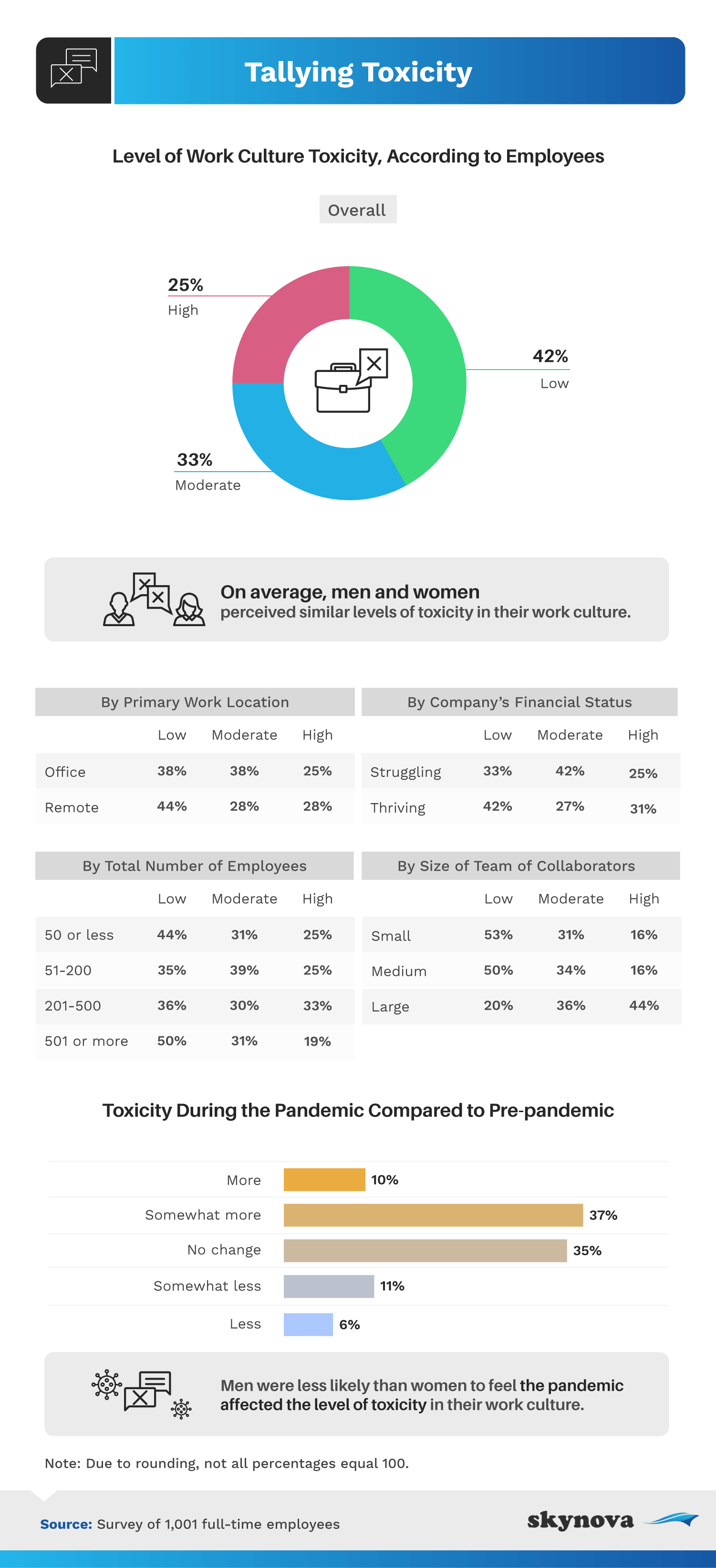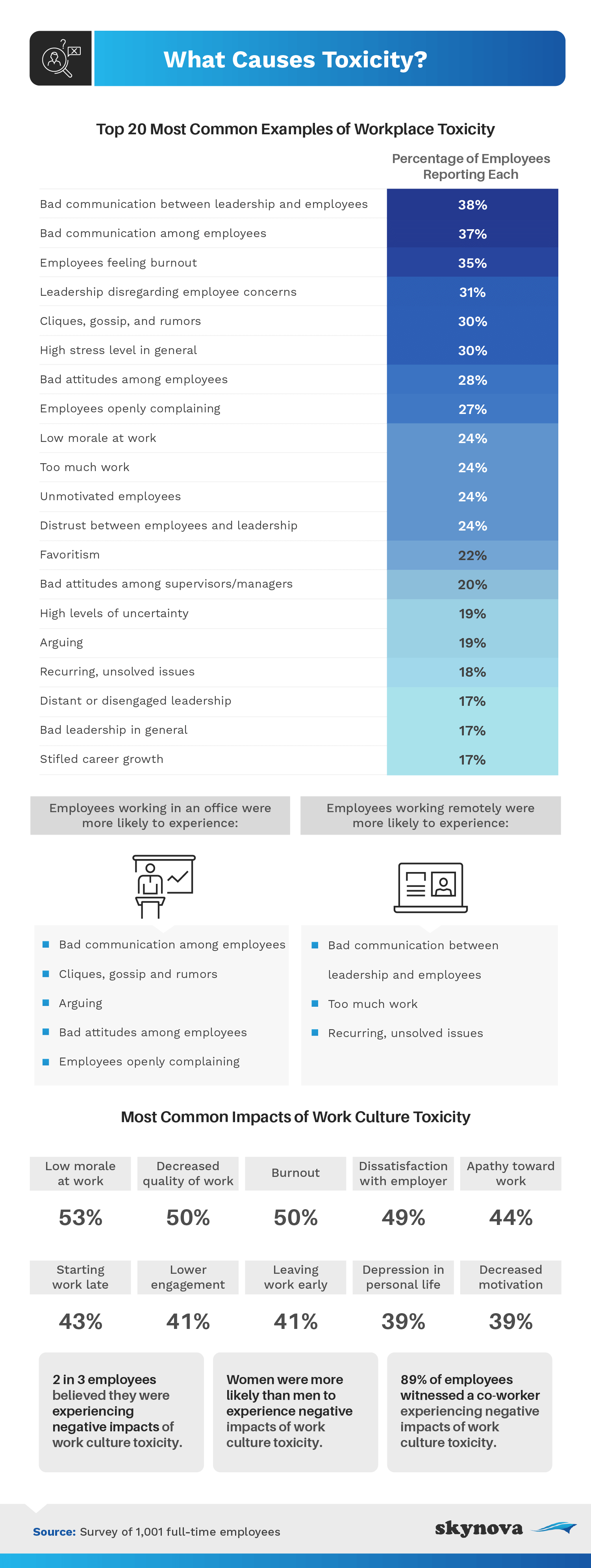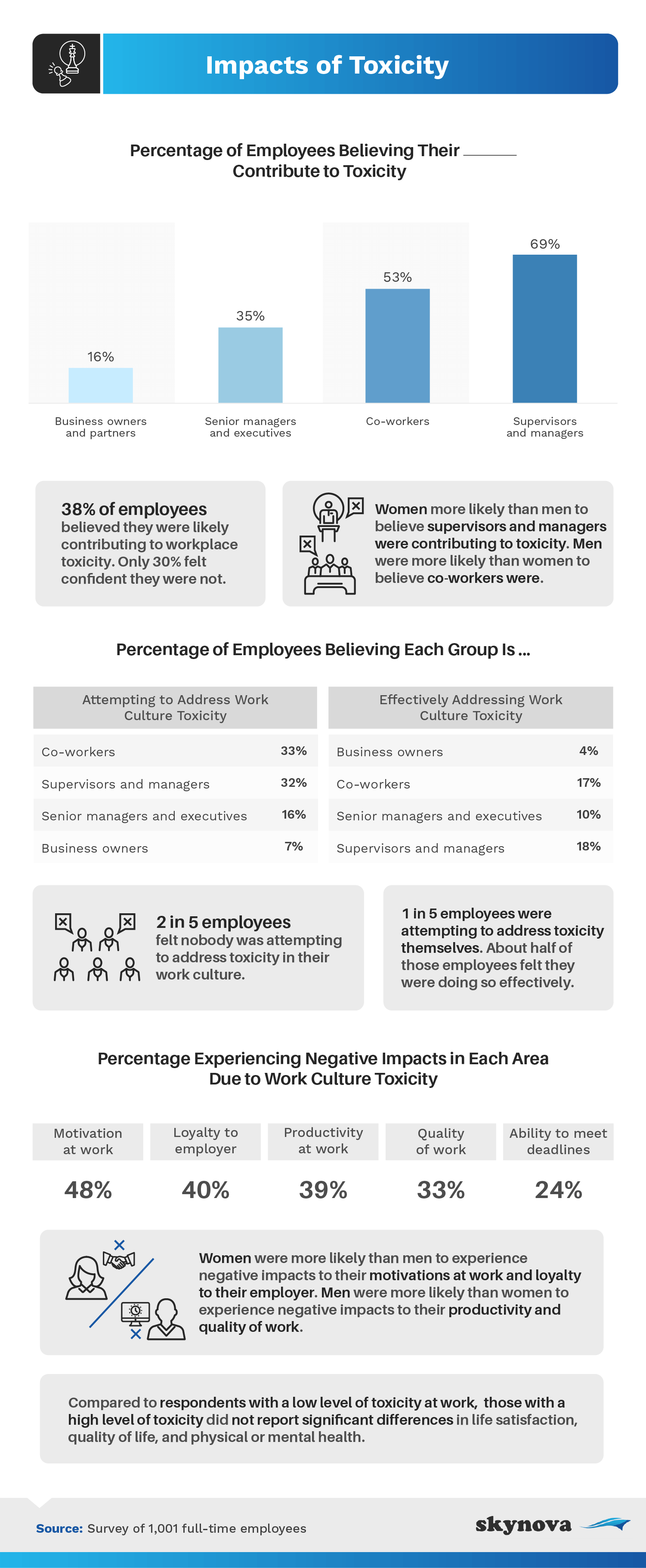
|
The manager who barely talks to you, the co-workers who gossip behind one another’s backs, and the constant feeling of never catching a break: if that sounds like a typical day on the job, you’re in a toxic work environment. As COVID-19 changes the working world, potentially forever, traits of toxic work environments are bound to change with it. Instead of overhearing co-workers talking about you in the break room, they’ll likely just start a private chat online. And instead of your boss expecting you to stay at the office well after the sun has set, they’ll just bombard you with emails and direct messages, blurring the boundary between work and home life.
How toxic work environments present themselves have likely changed. So, has toxic work culture increased as companies go virtual, too? What are the new warning signs and how do employees deal with it? We surveyed over 1,000 full-time employees to see how toxic work culture has changed during the pandemic and what people are doing about it. Keep reading to see what we found.
Some consequences of toxic workplaces are quite obvious: employee turnover increases, productivity plummets, and mental health worsens. But toxic work cultures impact more than just employees and their emotions; it also hurts a company’s bottom line. Over the past five years, companies lost a whopping $223 billion simply due to employee turnover. And the trend continues. According to our survey, a quarter of employees reported a high level of work culture toxicity, while a third said the toxicity was moderate.

However, despite online workspaces opening doors for new forms of toxicity, employees working on-site reported more severe cases of workplace toxicity. Compared to 56% of remote workers, 63% of employees working in the office experienced moderate to high toxicity. Similarly, severity increased for those whose company was struggling financially: 58% of employees at thriving businesses experienced moderate to high toxic work culture, while 67% of employees at struggling businesses said the same.
While many factors other than work location and finances likely play a role in the level of toxicity, the pandemic doesn’t seem to be one of the strongest catalysts. Only 10% of employees said they experienced more toxicity during the pandemic than before, while 35% said there was no change.
Whether in office or virtually, toxic work cultures manifest in various ways, with the most common stemming from communication (or a lack of it). Bad communication between leadership and employees and bad communication among employees topped the charts, followed by employees feeling burned out.

Cliques, gossip, and rumors may be one of the easiest signs to identify as toxic, but these were slightly less common than leadership disregarding employee concerns. Employees who worked in an office were also more likely to experience cliques, gossip, and rumors than those who worked remotely. On the flip-side, remote workers experienced bad communication between leadership and employees, too much work, and recurring, unsolved issues more often than their in-office counterparts.
Gossip and poor communication may seem like minor issues in the grand scheme of things, but work toxicity as a whole can have severe consequences on mental and physical health. While serious side effects can be hard to attribute to work toxicity, employees had no trouble identifying numerous side effects. Fifty-three percent of employees reported toxicity leading to low morale at work, while half also reported decreased quality of work and burnout. Dissatisfaction with employers and apathy toward work were also incredibly common.
If toxic workplaces have a high turnover, it might not be the employees instigating the toxicity. In fact, the root of the problem likely lies in middle management. According to employees surveyed, nearly 70% named supervisors and managers as contributors to toxicity, while 53% blamed their co-workers. Senior managers and executives were named as contributors by only 35% of respondents and business owners and partners even less so. But the blame wasn’t only cast on others – 38% of employees believed they were likely contributing to workplace toxicity, and only 30% felt confident they were not.

If middle management is the biggest contributor, who is left to fix the problem? A third of employees believed co-workers were attempting to address work culture toxicity, while 32% believed supervisors and managers were doing the same. However, they weren’t very effective in doing so. Only 18% of employees thought supervisors and managers were effectively addressing the issue.
Leaving work culture toxicity unaddressed can wreak havoc on employees and the company altogether. Nearly half of employees surveyed reported experiencing negative impacts on their motivation at work. Forty percent of employees also had their loyalty to their employer tested by toxicity, while productivity, quality of work, and ability to meet deadlines also suffered.
Workplace toxicity has likely been around since the first office opened, and it’s unlikely to ever be completely absent. But there is plenty for companies to do to ensure the level of toxicity remains minimal and that employees’ mental and physical health are preserved. Look out for the subtle signs of workplace toxicity like meetings after meetings, low energy, and poor communication – and then act quickly. On top of taking care of their employees, businesses who nip toxicity in the bud are also protecting their own successes – keeping the best employees on board and eliminating high turnover keeps more money in the company’s pocket.
Skynova simplifies the process of submitting invoices, keeping track of accounting, and creating accurate time sheets with our online software. From templates to invoice tracking, our services were designed with small businesses in mind so you can get paid faster. We also write articles about interesting topics to help keep our readers and customers informed. Our articles cover everything from business and workplace topics to technology, politics, sports, health, and more. Every article we publish is based on statistical surveys conducted by us to ensure our readers have access to novel insights and perspectives.
For this study, we surveyed 1,001 respondents. Among these, 544 were men, 454 were women, and three did not identify as either male or female. Our respondents ranged in age from 18 to 78, and our average respondent was 37.
To help ensure accurate responses, all respondents were required to identify and correctly respond to a decoyed attention-check question. In some cases, questions and answers have been paraphrased or rephrased for clarity or brevity. These data rely on self-reporting. Potential issues with self-reported data include telescoping, selective memory, and attribution errors.
To prevent workplaces from becoming highly toxic, employers and employees need to know what to look out for. If you know someone who could benefit from this study’s findings, feel free to share it with them for noncommercial purposes. All we ask is that you include a link back to this page so readers can see our project in its entirety and its creators can receive proper credit.